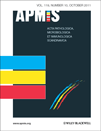The use of Gram stain and matrix-assisted laser desorption ionization time-of-flight mass spectrometry on positive blood culture: synergy between new and old technology
Abstract
Fuglsang-Damgaard D, Nielsen CH, Mandrup E, Fuursted K. The use of Gram stain and matrix-assisted laser desorption ionization time-of-flight mass spectrometry on positive blood culture: synergy between new and old technology. APMIS 2011; 119: 681–88.
Matrix-assisted laser desorption ionization time-of-flight mass spectrometry (MALDI-TOF-MS) is promising as an alternative to more costly and cumbersome methods for direct identifications in blood cultures. We wanted to evaluate a simplified pre-treatment method for using MALDI-TOF-MS directly on positive blood cultures using BacT/Alert blood culture system, and to test an algorithm combining the result of the initial microscopy with the result suggested by MALDI-TOF-MS. Using the recommended cut-off score of 1.7 the best results were obtained among Gram-negative rods with correct identifications in 91% of Enterobacteriaceae, 83% in aerobic/non-fermentative Gram-negative rods, whereas results were more modest among Gram-positive cocci with correct identifications in 52% of Staphylococci, 54% in Enterococci and only 20% in Streptococci. Combining the results of Gram stain with the top reports by MALDI-TOF-MS, increased the sensitivity from 91% to 93% in the score range from 1.5 to 1.7 and from 48% to 85% in the score range from 1.3 to 1.5. Thus, using this strategy and accepting a cut-off at 1.3 instead of the suggested 1.7, overall sensitivity could be increased from 88.1% to 96.3%. MALDI-TOF-MS is an efficient method for direct routine identification of bacterial isolates in blood culture, especially when combined with the result of the Gram stain.




